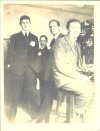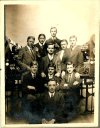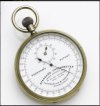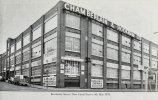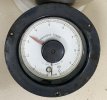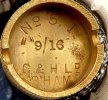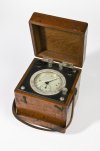I think 1898 in the name of Chamberlain and Hookham (this company was founded next door to the earlier Smith and Chamberlain). By 1927 it had become a subsidiary of the giant GEC, but it was still known as Chamberlain and Hookham. Hookham had been bought out early on.
The key man was Arthur Chamberlain who was one of five brothers of the famous Joseph Chamberlain who became Mayor. I extract his biography form Grace's Guide:
Chamberlain, Arthur (1842–1913), industrialist
1842 born on 11 April in Camberwell, Surrey, the third of six sons of Joseph Chamberlain (1796–1874), a wholesale shoe manufacturer, and Caroline, née Harben (1808–1875), daughter of a wealthy provision merchant. His eldest brother was
Joseph Chamberlain (1836–1914).
c.1858 On leaving school at the age of sixteen, Arthur followed Joseph into the wood-screw business of
Nettlefold and Chamberlain in Birmingham but he was not welcomed by Nettlefold
1863, his father put him in charge of another of his interests in Birmingham,
Smith and Chamberlain, brassfounders, which Arthur took into electric fittings.
1870 Arthur married Louisa Kenrick. They had two sons, Arthur (1880–1941) and John (1881–1917), who was killed in Flanders, and seven daughters, before Louisa died in 1892.
1874 The family sold their interest in the business.
1883 Arthur and George Hookham developed
Chamberlain and Hookham, next door to Smith and Chamberlain in New Bartholomew Street.
1886 Chamberlain and Hookham won the contract to install electric light in Birmingham Art Gallery but subsequently concentrated on the manufacture of meters.
1888 He was called in by shareholders of
Kynochs to rescue the business
1889 became chairman of Kynochs. He restructured the business and doubled output within 8 years as well as adding new product lines, moving into the munitions business and taking over several other firms.
1890 He was one of the first to reduce the working week from 60 to 48 hours; he gave clerks and foremen 14 days paid holiday and a pension after 10 years' service.
By 1891 Chamberlain had entered the tube-making business through Endurance Seamless Tube and Vial Co.
Mid-1890s he took over another ailing Birmingham firm,
Weldless Tube Co, and merged it with others, but was hit by the collapse of the cycle boom.
1896 Endurance became
Endurance Tube and Engineering Co and opened a factory in King's Norton with, as co-directors, son-in-law John Sutton Nettlefold and George Hookham, while his son John worked for Chamberlain and Hookham.
1898 Weldless Tubes and others were reconstructed into
Tubes Ltd; his son and grandson, both Arthurs, were involved in the management for many years.
Also had interests in
Hoskins and Son, makers of ships' berths, and
Elliotts Metal Co, makers of ships' sheathing.
1913 Died in Devon
Source:
https://www.gracesguide.co.uk/Arthur_Chamberlain
You can read more about the Chamberlains here
https://chamberlainhighburytrust.co.uk/2021/04/28/joseph-chamberlains-time-in-birmingham/
